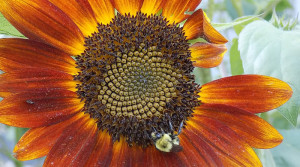
Read Part 2 of this Interview.
IJ: Bhante, thanks so much for being with us again to talk about the second satipaṭṭhāna. Maybe we can start with how to begin incorporating contemplation of vedanā into one’s overall practice. Should time be set aside to work just with vedanā, or should it be slowly brought into one’s primary practice?
BhA: The way I usually teach is to first work through all the four satipaṭṭhānas, and then come to an undirected type of awareness. In this way one gradually builds up by being aware of the bodily component, vedanā, mental states, and then the dhammas, which in the vision of satipaṭṭhāna that emerges from comparative study, is just the hindrances and the awakening factors.
After working through the four satipaṭṭhānas, you arrive at this more general resting in awareness. And because you have already gone through the vedanā component, you can then be aware of it as just part of your experience without needing to pay any special attention to it. And whenever vedanā has an impact on your experience – say you suddenly get a very painful or very pleasant feeling – you recognize it as simply part of the overall experience.
At that point, you keep the receptive stance of simple open awareness. You are just being mindful – simply allowing things to unfold naturally. There is the body, and you are aware of that. There is the present moment, and you are aware of its hedonic tone (which is vedanā) and of how your mind reacts or does not react to it, what its present condition is (citta). On top of that, you are aware of whether this whole situation is becoming a hindrance or is leading toward the final goal.
 IJ: What exactly does that detailed work look like? Should one focus on particular parts of the body – shoulder is unpleasant, knee is pleasant – or should it just be feeling a general sense of pleasant, unpleasant, neutral, pleasant, and so on?
IJ: What exactly does that detailed work look like? Should one focus on particular parts of the body – shoulder is unpleasant, knee is pleasant – or should it just be feeling a general sense of pleasant, unpleasant, neutral, pleasant, and so on?
BhA: There are different approaches, and I don’t think it’s good to narrow it down to one particular way. When I teach, I work through the four satipaṭṭhānas. Because you have already done the body scan for body contemplation, you can use that same scanning for feeling, understanding that the feeling of bodily sensations is an aspect of vedanā. From there you can open up to whatever feelings happen in general.
In the case of mindfulness of breathing, you can use the more specific sensation of the breath wherever you feel it. And from there you can open up to just being aware of the feeling component of experience in general without locating it anywhere in particular. The key issue is to recognize the hedonic tone: what happens right now and here, does it feel pleasant, does it feel unpleasant, or does it feel neutral to me?
IJ: What sorts of common mistakes or misconceptions do meditators make with respect to vedanā practice?
BhA: One could be a basic misunderstanding that confuses vedanā with emotions. Vedanā are not emotions. They’re just this hedonic tone of pleasant, unpleasant, and neutral. Emotions are rather states of mind. Another possible shortcoming is to reduce vedanā only to the bodily component. Vedanā is by definition both bodily and mental. It’s the link between body and mind. There can be vedanā of the body – if I hurt myself and then experience physical pain. On the other hand, somebody might say something unpleasant about me. The ear is not in pain – it’s the mind that is in pain. This is a mental feeling. If you want to get the full potential of contemplation of vedanā, it would be good to be aware of both bodily and mental feelings, without narrowing it down to only one or the other.
IJ: Is it important to focus on vedanā as it operates within the links of dependent arising? That is, should one work with how contact leads to vedanā, and how vedanā leads to craving, rather than just working with vedanā all by itself?
BhA: The effects of vedanā are to some extent covered by the Satipaṭṭhāna-sutta instructions in the way I understand them. After bringing in the basic distinction between pleasant, unpleasant, and neutral, the discourse then speaks of worldly and unworldly (sāmisa and nirāmisa). The way I understand this distinction is that each of these three types of feeling can be of a worldly or an unworldly type. For example, there is the joy one feels while reading a beautiful verse in the Dhammapada, and there is the joy one feels while eating chocolate cake: these two types of joy are different by nature. The feeling of joy as such is just pleasant feeling, but they lead in different directions. This is where vedanā comes in, and this is how contemplation of vedanā connects to contemplation of mind. Because the two really go together. You fully understand the one only when you also practice the other.
As one keeps practicing contemplation of the mind and recognizing, for example, this is a state of greed for chocolate cake. I’m recognizing this is sensual desire. And as one familiarizes oneself with the mental condition that one experiences when fantasizing about chocolate cake, one also becomes more attuned to the type of pleasant feelings that one feels when thinking about it or when getting it, as well as the painful feeling when one does not get it, because someone else took the last piece just before we could get it.
Alternatively, when one reflects on some beautiful verse from the Dhammapada, one can become accustomed to that type of pleasant state of mind and to that type of joy and the feeling of pleasantness that one has at that time. With continued contemplation one becomes more and more aware that there is a different energy in the pleasant feeling associated with chocolate cake and the pleasant feeling associated with the Dhammapada verse.
Once one has trained in that way – and this is a powerful aspect – when something is just about to arise in the mind, but before it has fully manifested – even before you could say it or type it out in words – when it’s still just beginning to come up, at that time a particular feeling is already there. And if I’ve trained myself in recognizing the distinction between a worldly and an unworldly feeling, alongside training in contemplation of the mind, at that time I can actually realize what’s happening even before it fully arises.
You can feel the arising of sensual desire even when it just starts, before the concept of chocolate cake has fully formed in the mind. Or say it’s irritation or anger – you can feel it before the mind starts to roll into, “So-and-so shouldn’t have said this, and next time I’m going to . . .”
Before all this starts, there’s first an arousing of anger, which has a very clear and distinct feeling to it. If at that moment I can recognize what is happening – and I can only recognize it through feeling at this early stage – I can nip it in the bud. Before the whole thing starts to formulate itself and rationalize itself it’s much easier to stop it – to stop it right there and then. This is how contemplation of feeling – and specifically this aspect of worldly and unworldly – can be a big boost for cultivating wholesome states of mind and avoiding unwholesome states of mind. We can meet them and recognize them when they’re still very weak and before they have gathered strength in the mind.
IJ: How exactly can you “stop it right there?” Is it just by recognizing it? Or is there some other movement?
BhA: At that stage, just the recognition is enough.
 IJ: And at that point, can you recognize it just by saying, “Worldly unpleasant” or “Worldly pleasant”?
IJ: And at that point, can you recognize it just by saying, “Worldly unpleasant” or “Worldly pleasant”?
BhA: Using terms can be helpful but isn’t strictly necessary – you only have to realize what’s happening. For that you don’t have to use a specific phrase. When you feel it starting to build up, if you see it at that time, it’s a sort of smiling recognition because it’s very weak and has not built up any strength. And then – poof! – it just goes.
IJ: Is the actual hedonic tone different between, say, pleasant worldly and pleasant unworldly?
BhA: They are both hedonically pleasant. This is what hedonic is all about. I have been thinking about why these specific terms – worldly and unworldly – have been used, because we also find them in the Chinese parallels. It would be much easier to say kusala and akusala (wholesome and unwholesome). I suppose, and this is just a guess, that the distinction between wholesome and unwholesome focuses on intention. But feelings are not intentional. Feelings have their impact at a stage before we form intentions. We do not intentionally have these feelings. We react to feelings with intention. So this may be why wholesome and unwholesome are not being used – because they have this flavor of distinguishing between intentions and states of mind. And feeling comes just before that.
IJ: So is it fair to say that some feelings are related to either wholesome or unwholesome intentions, or does the wholesomeness or unwholesomeness happen after that?
BhA: In the end, we are talking about a process. What is first, the feeling or the state of mind? Both happen together. They influence each other. If we try to cut it down to these minute parts, I’m not sure that would be helpful. We just understand the process. There’s a mental process, and at some point an object arises, and that causes feeling. And those feelings then cause reactions. And those reactions cause more feelings, and it goes back and forth. But of course there is a feeling in every moment of conscious experience.
IJ: So is it mostly about being aware of the nature of the object and how particular kinds of objects – say chocolate cake versus the Dhammapada – give rise to different kinds of feeling?
BhA: Every state of mind comes with a certain feeling. And this can be recognized. As we are talking, we could be experiencing negative or positive or neutral feelings. Maybe somebody reading this later will find it boring – neutral feelings. Maybe someone gets upset because something I said doesn’t make sense – painful feelings. Or just maybe one or two people might even like it, so they get pleasant feelings.
It’s very simple. It’s just the recognition of how feeling influences me and makes me react. If I start reading and I don’t like this Anālayo for some reason, there will already be some underlying painful feelings. Everything will be read in that light, and I’ll pick out all the things that I don’t like. If I like Anālayo, it will be just the opposite. Feeling has a big part to play in the whole conditioning process. That is why we hold on to our views and opinions and who we are – because we are hedonically invested in them.
IJ: In your first book, you write that “by fully understanding the role of feeling as a link between contact and craving, the view-forming process itself can be transcended.” (Satipaṭṭhāna: The Direct Path to Realization, 161) Can you say a little about the relationship between feeling and craving?
 BhA: The potential of contemplation of feeling – and I believe this is also why feeling is a satipaṭṭhāna on its own – comes from the pivotal role it plays within dependent arising. When we look at some of the preceding links of dependent arising, whatever happens before craving you can’t do much about. The sense-spheres are there, contact is there, and feeling happens. But at the point of feeling, the question is how do I react to feeling? Do I react with craving, or do I not react with craving?
BhA: The potential of contemplation of feeling – and I believe this is also why feeling is a satipaṭṭhāna on its own – comes from the pivotal role it plays within dependent arising. When we look at some of the preceding links of dependent arising, whatever happens before craving you can’t do much about. The sense-spheres are there, contact is there, and feeling happens. But at the point of feeling, the question is how do I react to feeling? Do I react with craving, or do I not react with craving?
Now as we talk, we can make it sound like there’s a choice, but in actuality it just happens. We never really decide, “Oh, here’s a feeling. Let me react with craving now. Or let me react without craving.” It just happens. Why does it happen so quickly? Because feeling has this push. Many thousands of years ago, say you were walking through a jungle and suddenly something is in front of you. For you to survive, within a split second you have to decide. Either this is too big for me, and I have to run. Or this is smaller than me, and I can catch it. And this is where vedanā comes in. The first perception gives a big push in one direction.
But in our modern world, we usually don’t turn a corner in the jungle and meet an unexpected animal. So this very quick reaction through vedanā can create a lot of problems. You can’t just stop it, but you can be aware of it – and that makes a world of difference. If I am upset with somebody, and I’m aware of the unpleasant feelings I have within me, it makes a whole world of difference how I will react to that person. If I like somebody, I see everything that he or she does in a positive light. If I’m aware of that pleasant feeling, it makes a whole world of difference: I become aware of my bias.
Because each of the three types of feeling are related to what in early Buddhist thought we call ‘underlying tendencies’ (anusaya). These are parts of the mind that underly – we are not really conscious of them. They are tendencies toward reacting with defilements – with desire, aversion, and delusion. And each of these three tendencies matches one of the feelings. Pleasant feelings can activate the tendency to lust, unpleasant feelings to anger, neutral feelings to ignorance.
The way to become aware of what is happening, which is the foundation for being able to do anything about it, is precisely at vedanā – being aware of the three types of feeling and getting used to this basic recognition: pleasant feeling, unpleasant feeling, neutral feeling. That’s what contemplation of feeling is about, and cultivating that type of recognition gives us a very powerful tool for working with our own conditionality.
IJ: So even in one’s daily life, one could practice catching things more and more quickly. If someone says something I don’t like, the sooner I can recognize unpleasant feeling in myself, the sooner I can cut it off.
 BhA: You don’t always have to cut it off. It’s just a question of being aware. Sometimes it only happens later, but you can still recognize, “At that point I got greedy or I got angry, and that was the feeling I had at that time.” With practice you come closer and closer to when it actually happens. But it helps us to understand why we react in certain ways.
BhA: You don’t always have to cut it off. It’s just a question of being aware. Sometimes it only happens later, but you can still recognize, “At that point I got greedy or I got angry, and that was the feeling I had at that time.” With practice you come closer and closer to when it actually happens. But it helps us to understand why we react in certain ways.
At times we do silly things, and we are very good at explaining to ourselves and others why we had to do this and what were the big, deep reasons behind what we did. What actually pushes us to do silly things is usually vedanā. It’s the push of vedanā, which in cooperation with unwholesome states of mind arising through the underlying tendencies leads to more vedanā, and etc. It builds up.
So what we really want is yathābhūtañānadassana: seeing things as they really are. “No, I did not get angry because he or she said such-and-such. I just got angry because this body is giving me painful feelings. And it’s my perception of him or her that gives me these painful feelings.” And that’s so sobering. At first it might seem a little bit depressing, but in the long run it can be so liberating.
IJ: So even though on one level just going, “Pleasant . . . neutral . . . pleasant . . . unpleasant . . .” doesn’t seem very interesting, it can decondition us on a very deep, subconscious level.
BhA: Yes, but you do not have to keep labeling all the time. You just have to be aware of the nature of experience. You don’t have to keep applying concepts to it continuously. It would be very tiring if you just kept going, “Pleasant . . . unpleasant . . . neutral . . .” This is not what we’re talking about. What we’re talking about is being aware of this aspect of the mind that is always there – this hedonic, affective knowing of the mind. And when it does something, you recognize it. Maybe at times you recognize it only after it has happened. You have already yelled at somebody, and then later you realize, “Wow. For the last half an hour I’ve been experiencing painful feeling, haven’t I?”
This is how you come to know: “Oh, this is how I feel when I have painful feeling.” As you keep familiarizing yourself with that condition, it becomes easier to catch it – to be aware of it earlier. It’s just a question of being aware – not of continuous conceptual labeling.
I sometimes like to say that concepts are like the yeast for baking the bread of meditation. If you use only yeast, what are you going to eat? But if you want to bake the bread of meditation, you have to use the proper amount of yeast so that the bread goes up. But the real thing is not the yeast. It’s the dough and the kneading and the warmth of actually sitting in the practice that makes the bread. So the concepts should not be used in such a way that they tire the mind. We just use them very judiciously, very wisely, like the yeast for the bread, just the right amount.